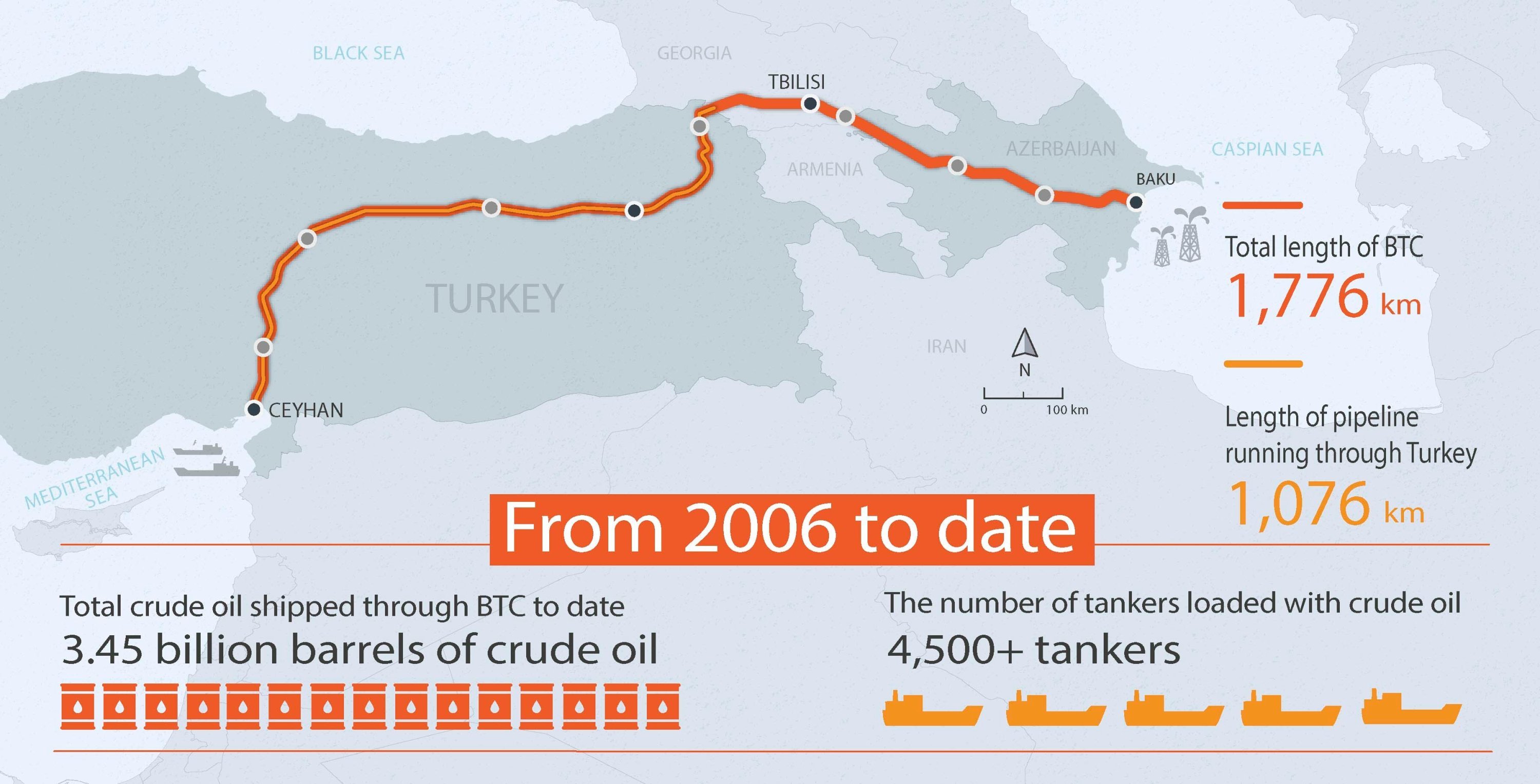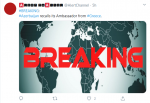You are using an out of date browser. It may not display this or other websites correctly.
You should upgrade or use an alternative browser.
You should upgrade or use an alternative browser.
WAR Main Armenia Versus Azerbaijan War Thread - Open Hostilities Underway Now
- Thread starter WTSR
- Start date
northern watch
TB Fanatic
night driver
ESFP adrift in INTJ sea
Jules, remember the "Little Green Men" from Ukraine??
They were Wagner Group more or less. Wagner Group recruited them. which is why they accepted they had gone to Ukraine to die.
They were Wagner Group more or less. Wagner Group recruited them. which is why they accepted they had gone to Ukraine to die.
northern watch
TB Fanatic
Greece recalls its ambassador to Azerbaijan
Greece’s Foreign Ministry says it is recalling its ambassador to Azerbaijan following what it says are “completely unfounded and insulting allegations” by the Azerbaijani government that it is tolerating the preparation of terrorist acts
By The Associated Press
7 October 2020
ATHENS, Greece -- Greece’s Foreign Ministry says it is recalling its ambassador to Azerbaijan following what it says are “completely unfounded and insulting allegations” by the Azerbaijani government that it is tolerating the preparation of terrorist acts.
In a statement Wednesday, the ministry said the Greek ambassador had been recalled to Athens for consultations. It said the Azerbaijani government had claimed Greece was tolerating the preparation of terrorist acts, attempts to recruit terrorist fighters and cyberattacks against Azerbaijan due to the latter’s conflict with Armenia over the separatist region of Nagorno-Karabakh.
The ministry said it had filed a protest over the issue on Tuesday with the Azerbaijani ambassador in Greece.
Earlier this month, the Azerbaijani Ministry of Foreign Affairs cited media reports and other information that it said indicated that “thousands of ethnic Armenians” from several countries, including Greece, were heading to Nagorno-Karabakh.

 abcnews.go.com
abcnews.go.com
Greece’s Foreign Ministry says it is recalling its ambassador to Azerbaijan following what it says are “completely unfounded and insulting allegations” by the Azerbaijani government that it is tolerating the preparation of terrorist acts
By The Associated Press
7 October 2020
ATHENS, Greece -- Greece’s Foreign Ministry says it is recalling its ambassador to Azerbaijan following what it says are “completely unfounded and insulting allegations” by the Azerbaijani government that it is tolerating the preparation of terrorist acts.
In a statement Wednesday, the ministry said the Greek ambassador had been recalled to Athens for consultations. It said the Azerbaijani government had claimed Greece was tolerating the preparation of terrorist acts, attempts to recruit terrorist fighters and cyberattacks against Azerbaijan due to the latter’s conflict with Armenia over the separatist region of Nagorno-Karabakh.
The ministry said it had filed a protest over the issue on Tuesday with the Azerbaijani ambassador in Greece.
Earlier this month, the Azerbaijani Ministry of Foreign Affairs cited media reports and other information that it said indicated that “thousands of ethnic Armenians” from several countries, including Greece, were heading to Nagorno-Karabakh.

Greece recalls its ambassador to Azerbaijan
Greece’s Foreign Ministry says it is recalling its ambassador to Azerbaijan following what it says are “completely unfounded and insulting allegations” by the Azerbaijani government that it is tolerating the preparation of terrorist acts
northern watch
TB Fanatic
jward
passin' thru
Jules, remember the "Little Green Men" from Ukraine??
They were Wagner Group more or less. Wagner Group recruited them. which is why they accepted they had gone to Ukraine to die.
Yup, they taught me that in the regional thread. What i was wondering though was if sending wagner in meant that Russia was still holding back in it's official guise, and thus that spoke to a better chance of restraint and coming out of this FUBAR w/ the least amount of damage, and official participants. . . :: shrugs :: I gotta pay better attention to my teacher, I see : )
jward
passin' thru
TurkishFacts4u
@TurkishFacts4U
43s
Nuclear power #Pakistan expresses its unequivocal support to #Azerbaijan. #Turkey-#Pakistan-#Azerbaijan
View: https://twitter.com/TurkishFacts4U/status/1314054606922473473?s=20
@TurkishFacts4U
43s
Nuclear power #Pakistan expresses its unequivocal support to #Azerbaijan. #Turkey-#Pakistan-#Azerbaijan
View: https://twitter.com/TurkishFacts4U/status/1314054606922473473?s=20
jward
passin' thru
The War Zone
@thewarzonewire
2h
Satellite images confirm Turkish F-16 fighters secretly deployed to Azerbaijan:
View: https://twitter.com/thewarzonewire/status/1314019552674500608?s=20
@thewarzonewire
2h
Satellite images confirm Turkish F-16 fighters secretly deployed to Azerbaijan:
View: https://twitter.com/thewarzonewire/status/1314019552674500608?s=20
The War Zone
@thewarzonewire
2h
Satellite images confirm Turkish F-16 fighters secretly deployed to Azerbaijan:
View: https://twitter.com/thewarzonewire/status/1314019552674500608?s=20
View: https://twitter.com/trbrtc/status/1313903827435892737
There are at least two F-16s at Ganja International Airport in Azerbaijan, our analysis of an Oct. 3
@planetlabs
satellite image shows. The fighter jets are likely operated by the Turkish Air Force, alongside a possible CN-235 cargo aircraft. Here’s a short thread why.

11:07 AM · Oct 7, 2020·Twitter Web App
3.3K
Retweets
1.8K
Quote Tweets
4.6K
Likes

Christiaan Triebert
@trbrtc
·
14h
Replying to
@trbrtc
We compared the approximate measurements and visual characteristics (canard wings, color, etc.) with a variety of aircraft, including those operated by the Azerbaijani Air Force (MiG-21, MiG-29, Su-25, L-39). The Turkish-operated F-16 is the closest match.
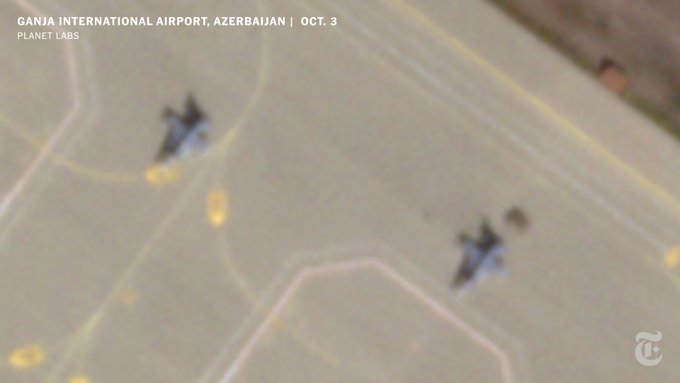

Christiaan Triebert
@trbrtc
·
14h
There's also a larger aircraft on the Ganja apron, which we think is likely to be a CASA/IPTN CN-235 transport aircraft, also used by the Turkish Air Force. (It does resemble an Alenia C-27 too, but less likely to be in Azerbaijan due to its operators). https://planespotters.net/photo/865513/92-056-turkish-air-force-casa-cn-235-100m
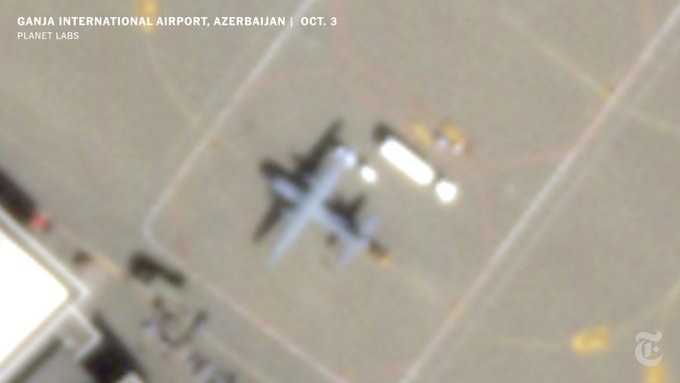
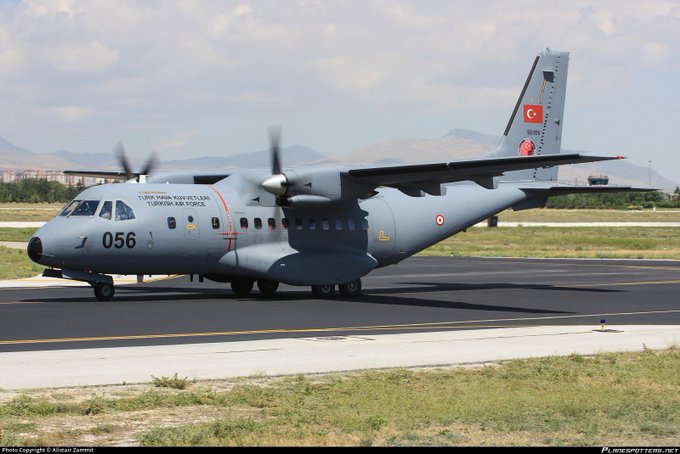
https://pbs.twimg.com/media/EjvtuLjXkAwHeBQ?format=jpg&name=small
northern watch
TB Fanatic
jward
passin' thru

Deven_Intel
@Deven_Intel
#Russia says it has invited the foreign ministers of #Armenia & #Azerbaijan to Moscow for consultations on a peace settlement as fighting continues & the death toll continues to increase between the two nation's.
jward
passin' thru
Half of Nagorno-Karabakh population displaced by Armenia and Azerbaijan clashes
As mediators prepare to meet in Geneva, officials say up to 75,000 people have been forced to flee fighting in breakaway region
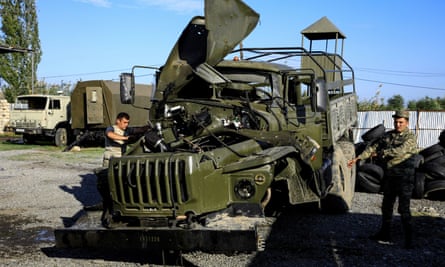
An Armenian military truck damaged in fighting with Azerbaijan over the breakaway region of Nagorno-Karabakh. Photograph: Ümit Bektaş/Reuters
Agence France-Presse
Wed 7 Oct 2020 22.34 EDT
160
Clashes between Armenian and Azerbaijani forces have displaced half of the population of the breakaway Nagorno-Karabakh region, according to its rights ombudsman, as international mediators were set to hold their first meeting in Geneva.
Russian president, Vladimir Putin, urged an end to a “huge tragedy” in an interview with state-run television on Wednesday, as new strikes hit Karabakh’s main city Stepanakert and Armenia said the fighting was raging along the entire frontline.
Even if the longstanding conflict over the ethnic Armenian separatist region could not be resolved, a ceasefire must be agreed “as quickly as possible”, Putin said.
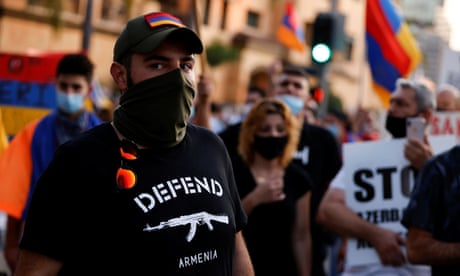
'Defend our nation': Armenian diaspora feels pull of another war
Read more
A few hours later Azerbaijan said its foreign minister, Jeyhun Bayramov, would visit Geneva on Thursday and meet leaders of the Organization for Security and Co-operation in Europe’s Minsk group, which is jointly chaired by diplomats from France, Russia, and the United States.
The fighting in one of the most lingering conflicts resulting from the fall of the Soviet Union erupted again on 27 September, with Azerbaijan insisting the region must return to its control.
Clashes had lasted “all day, along the whole front line and are continuing at the moment”, with the fiercest fighting in the south of Karabakh, Armenian defence ministry spokesman Artsrun Hovhannisyan told journalists, quoted by Russia’s Tass news agency.
Intermittent shelling by Azerbaijan’s forces has turned Stepanakert into a ghost town dotted with unexploded munitions and shell craters.
Much of Stepanakert’s 50,000-strong population has left, with those remaining hunkering down in cellars.
“According to our preliminary estimates, some 50% of Karabakh’s population and 90% of women and children – or some 70,000-75,000 people – have been displaced,” Karabakh’s rights ombudsman Artak Beglaryan told AFP Wednesday.
Azerbaijan has accused Armenian forces of shelling civilian targets in urban areas, including its second-largest city of Ganja.
Why are Armenia and Azerbaijan fighting and what are the implications?
Read more
Dozens of civilians have been confirmed killed in the fighting and the Armenian side has acknowledged more than 300 military deaths. Azerbaijan has not admitted to any fatalities among its troops.
Azerbaijani prosecutors said 427 dwellings populated by roughly 1,200 people had been destroyed.
The OSCE’s Minsk group has sought a solution to the conflict since the 1990s.
Armenia ruled out its foreign minister, Zohrab Mnatsakanyan, meeting his Azerbaijani counterpart in Geneva, however, saying “it is impossible to hold negotiations with one hand and continue military operations with the other”.
Russia announced its defence minister Sergei Shoigu had held talks with both his Armenian and Azerbaijani counterparts on Wednesday evening, without giving details.
The conflict has drawn in regional powers, with French foreign minister, Jean-Yves Le Drian, warning that Turkey’s backing of Azerbaijan risks fuelling the “internationalisation” of the conflict.
Le Drian, speaking to the French parliament, accused Azerbaijan of initiating the current conflict and lamented “the large number of civilian victims for the sake of meagre progress” on the ground.
Nagorno-Karabakh broke away from Azerbaijan in a war in the early 1990s that claimed the lives of some 30,000 people. The Armenian separatists declared independence.
The region’s 140,000 inhabitants are now almost exclusively Armenians after the remaining Azerbaijanis left during the war.
However, the international community regards it as part of Azerbaijan and no state, including Armenia itself, recognises its independence.
Sporadic fighting has erupted frequently since a May 1994 ceasefire, most notably in 2016.
But analysts say Turkey’s involvement this time has changed the landscape.
Turkey has reportedly sent pro-Ankara Syrian fighters to boost Azerbaijan forces and also home-produced drones that have already been deployed with success in Libya and Syria.
The UK-based Syrian Observatory for Human Rights says 1,200 fighters have been sent and at least 64 have died.
“The new aspect is that there is military involvement by Turkey which risks fuelling the internationalisation of the conflict,” Le Drian said.
Turkey’s foreign minister, Mevlut Cavusoglu, said on Tuesday the world should back Azerbaijan as “the side of those who are right”, describing Armenia as the “occupier”.
Russia has cordial relations and sells arms to both sides. But it has a military base in Armenia and Yerevan is a member of a Russia-led regional security group while Baku is not.
Armenia’s prime minister, Nikol Pashinyan, said he was confident Russia would come to its aid because of the two countries’ membership in the Collective Security Treaty Organisation military alliance (CTSO).
Putin in his interview emphasised that Moscow would fulfil its obligations, which analysts sometimes describe as a Russian Nato.
But he noted: “The hostilities, which to our great regret, continue to this day, are not taking place on the territory of Armenia.”
posted for fair use
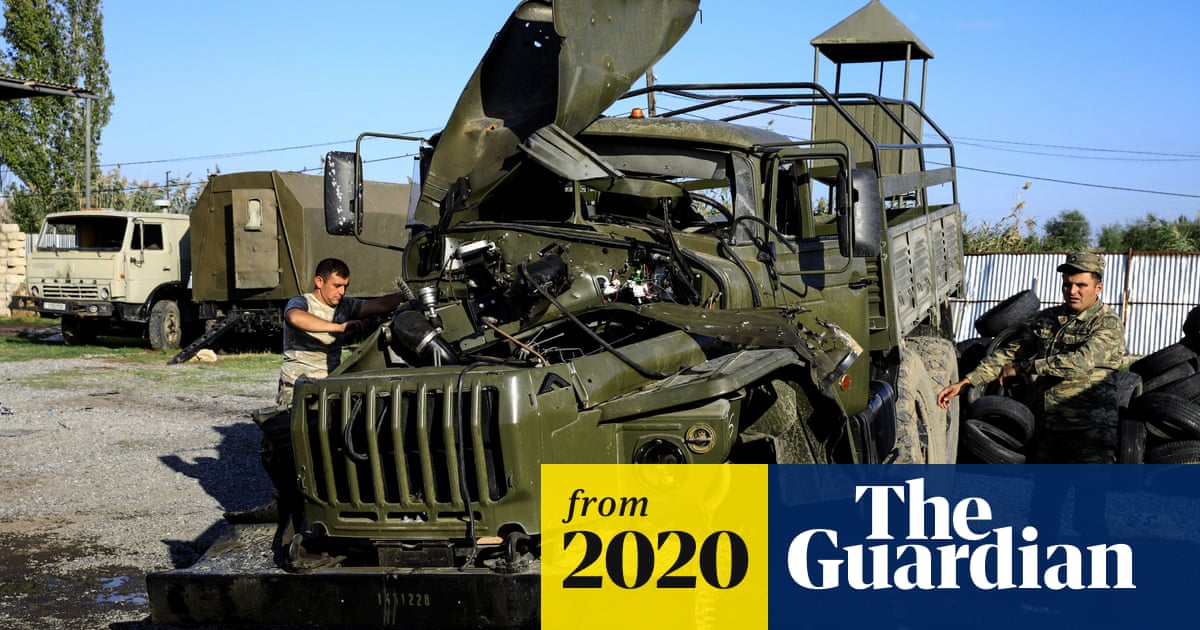
 www.theguardian.com
www.theguardian.com
As mediators prepare to meet in Geneva, officials say up to 75,000 people have been forced to flee fighting in breakaway region

An Armenian military truck damaged in fighting with Azerbaijan over the breakaway region of Nagorno-Karabakh. Photograph: Ümit Bektaş/Reuters
Agence France-Presse
Wed 7 Oct 2020 22.34 EDT
160
Clashes between Armenian and Azerbaijani forces have displaced half of the population of the breakaway Nagorno-Karabakh region, according to its rights ombudsman, as international mediators were set to hold their first meeting in Geneva.
Russian president, Vladimir Putin, urged an end to a “huge tragedy” in an interview with state-run television on Wednesday, as new strikes hit Karabakh’s main city Stepanakert and Armenia said the fighting was raging along the entire frontline.
Even if the longstanding conflict over the ethnic Armenian separatist region could not be resolved, a ceasefire must be agreed “as quickly as possible”, Putin said.

'Defend our nation': Armenian diaspora feels pull of another war
Read more
A few hours later Azerbaijan said its foreign minister, Jeyhun Bayramov, would visit Geneva on Thursday and meet leaders of the Organization for Security and Co-operation in Europe’s Minsk group, which is jointly chaired by diplomats from France, Russia, and the United States.
The fighting in one of the most lingering conflicts resulting from the fall of the Soviet Union erupted again on 27 September, with Azerbaijan insisting the region must return to its control.
Clashes had lasted “all day, along the whole front line and are continuing at the moment”, with the fiercest fighting in the south of Karabakh, Armenian defence ministry spokesman Artsrun Hovhannisyan told journalists, quoted by Russia’s Tass news agency.
Intermittent shelling by Azerbaijan’s forces has turned Stepanakert into a ghost town dotted with unexploded munitions and shell craters.
Much of Stepanakert’s 50,000-strong population has left, with those remaining hunkering down in cellars.
“According to our preliminary estimates, some 50% of Karabakh’s population and 90% of women and children – or some 70,000-75,000 people – have been displaced,” Karabakh’s rights ombudsman Artak Beglaryan told AFP Wednesday.
Azerbaijan has accused Armenian forces of shelling civilian targets in urban areas, including its second-largest city of Ganja.
Why are Armenia and Azerbaijan fighting and what are the implications?
Read more
Dozens of civilians have been confirmed killed in the fighting and the Armenian side has acknowledged more than 300 military deaths. Azerbaijan has not admitted to any fatalities among its troops.
Azerbaijani prosecutors said 427 dwellings populated by roughly 1,200 people had been destroyed.
The OSCE’s Minsk group has sought a solution to the conflict since the 1990s.
Armenia ruled out its foreign minister, Zohrab Mnatsakanyan, meeting his Azerbaijani counterpart in Geneva, however, saying “it is impossible to hold negotiations with one hand and continue military operations with the other”.
Russia announced its defence minister Sergei Shoigu had held talks with both his Armenian and Azerbaijani counterparts on Wednesday evening, without giving details.
The conflict has drawn in regional powers, with French foreign minister, Jean-Yves Le Drian, warning that Turkey’s backing of Azerbaijan risks fuelling the “internationalisation” of the conflict.
Le Drian, speaking to the French parliament, accused Azerbaijan of initiating the current conflict and lamented “the large number of civilian victims for the sake of meagre progress” on the ground.
Nagorno-Karabakh broke away from Azerbaijan in a war in the early 1990s that claimed the lives of some 30,000 people. The Armenian separatists declared independence.
The region’s 140,000 inhabitants are now almost exclusively Armenians after the remaining Azerbaijanis left during the war.
However, the international community regards it as part of Azerbaijan and no state, including Armenia itself, recognises its independence.
Sporadic fighting has erupted frequently since a May 1994 ceasefire, most notably in 2016.
But analysts say Turkey’s involvement this time has changed the landscape.
Turkey has reportedly sent pro-Ankara Syrian fighters to boost Azerbaijan forces and also home-produced drones that have already been deployed with success in Libya and Syria.
The UK-based Syrian Observatory for Human Rights says 1,200 fighters have been sent and at least 64 have died.
“The new aspect is that there is military involvement by Turkey which risks fuelling the internationalisation of the conflict,” Le Drian said.
Turkey’s foreign minister, Mevlut Cavusoglu, said on Tuesday the world should back Azerbaijan as “the side of those who are right”, describing Armenia as the “occupier”.
Russia has cordial relations and sells arms to both sides. But it has a military base in Armenia and Yerevan is a member of a Russia-led regional security group while Baku is not.
Armenia’s prime minister, Nikol Pashinyan, said he was confident Russia would come to its aid because of the two countries’ membership in the Collective Security Treaty Organisation military alliance (CTSO).
Putin in his interview emphasised that Moscow would fulfil its obligations, which analysts sometimes describe as a Russian Nato.
But he noted: “The hostilities, which to our great regret, continue to this day, are not taking place on the territory of Armenia.”
posted for fair use

Half of Nagorno-Karabakh population displaced by Armenia and Azerbaijan clashes
As mediators prepare to meet in Geneva, officials say up to 75,000 people have been forced to flee fighting in breakaway region
jward
passin' thru
..well. better than a poke to the eye I guess..
Aurora Intel
@AuroraIntel
#Azerbaijan and #Armenia have reportedly both agreed to join peace talks in #Moscow.

Deven_Intel
@Deven_Intel
#Russia says it has invited the foreign ministers of #Armenia & #Azerbaijan to Moscow for consultations on a peace settlement as fighting continues & the death toll continues to increase between the two nation's.
Aurora Intel
@AuroraIntel
#Azerbaijan and #Armenia have reportedly both agreed to join peace talks in #Moscow.
jward
passin' thru
Anush Ghavalyan
@aghavalyan
#Update from #NagornoKarabakh: Right now #Azerbaijan is intensively shelling #Stepanakert with heavy rockets.
1:35 AM · Oct 9, 2020·Twitter Web App
jward
passin' thru
Lebanon News
Oct. 09, 2020 | 09:58 AM (Last updated: October 09, 2020 | 10:00 AM)
Armenia-Azerbaijan conflict draws in fighters from Mideast
BEIRUT: For the past two weeks, Raffi Ghazarian has been glued to the TV at home and at work watching news about the fighting between Armenian and Azerbaijani forces. If it goes on, the 50-year-old Lebanese of Armenian descent says he’s ready to leave everything and volunteer to defend his ancestral land.
Some from Lebanon’s large ethnic Armenian population have already travelled to join the fight, according to members of the community, although they say the numbers are small.
The new eruption of violence in the Caucasus region strikes close to home for Lebanon’s Armenians. Red, blue and orange Armenian flags are flown on balconies, windows and roofs of buildings in Bourj Hammoud, Beirut’s main Armenian district. Anti-Turkish graffiti in English and Armenian mark walls all over the streets.
Fighting has raged since Sept. 27 in the separatist region of Nagorno-Karabakh, leaving several hundred dead. The enclave lies within Azerbaijan but has been under the control of ethnic Armenian forces backed by neighboring Armenia since 1994, when a truce ended a years-long war that killed an estimate 30,000 people.
On the other side of the latest fighting, Turkey has sent hundreds of Syrian opposition fighters to back its ally, Azerbaijan, according to a Syrian war monitor and three Syria-based opposition activists.
Lebanese-Armenians have been sending money and aid as well as campaigning in the media in support of ethnic Armenians in the enclave, which they refer to as Artsakh. The support they can give is limited - Lebanon is passing through a severe economic crisis, and banks have imposed tight capital controls.
Lebanon is home to one of the largest Armenian communities in the world, most of them descendants of survivors of the 1915 genocide by Ottoman Turks.
An estimated 1.5 million died in massacres, deportations and forced marches that began in 1915 as Ottoman officials worried that the Christian Armenians would side with Russia, its enemy in World War I.
The event is widely viewed by historians as genocide. Turkey denies the deaths constituted genocide, saying the toll has been inflated and that those killed were victims of civil war and unrest.
"We will not allow what happened in 1915 to happen again. We will fight until the last Armenian soldier," said Ghazarian, standing next to a coffee stand decorated with Lebanese and Armenian flags.
"This is not a war between Muslims and Christians. This is a war for the existence of the Armenian entity and we are ready," said Ghazarian, who owns a clothes shop.
Lebanese legislator Hagop Pakradounian, who heads the Armenian Revolutionary Federation, the largest and most powerful Armenian party in Lebanon, said volunteers going from Lebanon to Armenia act on their own, and there is no decision by any organization or the community itself to send them.
"We cannot tell them not to go. They are free," Pakradounian told The Associated Press in his office in Bourj Hammoud. "We consider it a war against all the Armenian people and a continuation of the genocide project since the Ottoman Empire."
Meanwhile, Turkey has sent more than 1,200 Syrian fighters - most of them members of Turkish-backed opposition groups - to fight alongside Azeri forces, according to the Britain-based Syrian Observatory for Human rights, an opposition war monitor that tracks Syria’s nine-year conflict. The Observatory’s chief, Rami Abdurrahman, said 72 Syrian fighters have been killed so far.
Three opposition activists in Syria corroborated the report. They said Turkish security companies recruit the men ostensibly to work as guards at oil facilities in return for around $1,200 a month, but most end up on front lines. One of the activists sent AP photos of young men allegedly killed in Azerbaijan.
A citizen journalist based in northern Syria said he knows some of the fighters who joined the battle, adding that warnings they sent about the intensity of the fighting and the dangers made others who were planning to go change their minds.
The deployment is similar to what happened in Libya, where battle-hardened Syrian fighters helped tip the balance of power in favor of the U.N.-supported government of Prime Minister Fayez Sarraj, an ally of Turkey.
Armenia has repeatedly said over the past week that Turkey sent Syrian fighters to back the Azeris, a claim that Ankara and Azerbaijan deny.
Syrian President Bashar Assad told Russia’s RIA Novosti news agency that Turkey is bringing "terrorists" from Syria and Libya to fight in Azerbaijan, accusing Turkish President Recep Tayyip Erdogan of being "behind the escalation in Nagorno-Karabakh."
French President Emmanuel Macron spoke with Russia’s Vladimir Putin about the conflict last week. Macron later told reporters he had information "that we’re confident in" confirming Turkey’s deployment of Syrian mercenaries in the fighting. "It’s a very serious new development that also changes the balance of things," he said.
Russia’s Foreign Ministry expressed concern over reports about "militants from illegal armed groups" from Syria and Libya being sent to the conflict zone.
Hikmet Hajiyev, a foreign policy aide to the Azerbaijani president, said this week that "we completely reject" the claim, calling on those who make the accusations to give evidence.
Maj. Youssef al-Hammoud, an official with the so-called Syrian National Army, an umbrella for Turkish-backed armed opposition groups in Syria, strongly denied in a telephone call with the AP that any fighters were being sent from Syria to Azerbaijan. "This is an Armenian media campaign," al-Hammoud said.
Lebanon’s Armenians are doing what they can to help. Yeghia Tashjian, a freelance researcher, said he was writing articles to raise awareness about what Armenians are being subjected to.
"For us, this is existential war that it is important to win not just for emotional or nationalist issues but because it is our homeland and we should fight for it," Tashjian said.
In Bourj Hammoud, Tro Mandalian, who works in a perfume distribution business, said Armenians’ opponents always had bigger armies but still Armenians survived. "We have strong hearts," he said.
"Let them try us," he said. "We don’t surrender and we only kneel to God."

 www.dailystar.com.lb
www.dailystar.com.lb
Oct. 09, 2020 | 09:58 AM (Last updated: October 09, 2020 | 10:00 AM)
Armenia-Azerbaijan conflict draws in fighters from Mideast
BEIRUT: For the past two weeks, Raffi Ghazarian has been glued to the TV at home and at work watching news about the fighting between Armenian and Azerbaijani forces. If it goes on, the 50-year-old Lebanese of Armenian descent says he’s ready to leave everything and volunteer to defend his ancestral land.
Some from Lebanon’s large ethnic Armenian population have already travelled to join the fight, according to members of the community, although they say the numbers are small.
The new eruption of violence in the Caucasus region strikes close to home for Lebanon’s Armenians. Red, blue and orange Armenian flags are flown on balconies, windows and roofs of buildings in Bourj Hammoud, Beirut’s main Armenian district. Anti-Turkish graffiti in English and Armenian mark walls all over the streets.
Fighting has raged since Sept. 27 in the separatist region of Nagorno-Karabakh, leaving several hundred dead. The enclave lies within Azerbaijan but has been under the control of ethnic Armenian forces backed by neighboring Armenia since 1994, when a truce ended a years-long war that killed an estimate 30,000 people.
On the other side of the latest fighting, Turkey has sent hundreds of Syrian opposition fighters to back its ally, Azerbaijan, according to a Syrian war monitor and three Syria-based opposition activists.
Lebanese-Armenians have been sending money and aid as well as campaigning in the media in support of ethnic Armenians in the enclave, which they refer to as Artsakh. The support they can give is limited - Lebanon is passing through a severe economic crisis, and banks have imposed tight capital controls.
Lebanon is home to one of the largest Armenian communities in the world, most of them descendants of survivors of the 1915 genocide by Ottoman Turks.
An estimated 1.5 million died in massacres, deportations and forced marches that began in 1915 as Ottoman officials worried that the Christian Armenians would side with Russia, its enemy in World War I.
The event is widely viewed by historians as genocide. Turkey denies the deaths constituted genocide, saying the toll has been inflated and that those killed were victims of civil war and unrest.
"We will not allow what happened in 1915 to happen again. We will fight until the last Armenian soldier," said Ghazarian, standing next to a coffee stand decorated with Lebanese and Armenian flags.
"This is not a war between Muslims and Christians. This is a war for the existence of the Armenian entity and we are ready," said Ghazarian, who owns a clothes shop.
Lebanese legislator Hagop Pakradounian, who heads the Armenian Revolutionary Federation, the largest and most powerful Armenian party in Lebanon, said volunteers going from Lebanon to Armenia act on their own, and there is no decision by any organization or the community itself to send them.
"We cannot tell them not to go. They are free," Pakradounian told The Associated Press in his office in Bourj Hammoud. "We consider it a war against all the Armenian people and a continuation of the genocide project since the Ottoman Empire."
Meanwhile, Turkey has sent more than 1,200 Syrian fighters - most of them members of Turkish-backed opposition groups - to fight alongside Azeri forces, according to the Britain-based Syrian Observatory for Human rights, an opposition war monitor that tracks Syria’s nine-year conflict. The Observatory’s chief, Rami Abdurrahman, said 72 Syrian fighters have been killed so far.
Three opposition activists in Syria corroborated the report. They said Turkish security companies recruit the men ostensibly to work as guards at oil facilities in return for around $1,200 a month, but most end up on front lines. One of the activists sent AP photos of young men allegedly killed in Azerbaijan.
A citizen journalist based in northern Syria said he knows some of the fighters who joined the battle, adding that warnings they sent about the intensity of the fighting and the dangers made others who were planning to go change their minds.
The deployment is similar to what happened in Libya, where battle-hardened Syrian fighters helped tip the balance of power in favor of the U.N.-supported government of Prime Minister Fayez Sarraj, an ally of Turkey.
Armenia has repeatedly said over the past week that Turkey sent Syrian fighters to back the Azeris, a claim that Ankara and Azerbaijan deny.
Syrian President Bashar Assad told Russia’s RIA Novosti news agency that Turkey is bringing "terrorists" from Syria and Libya to fight in Azerbaijan, accusing Turkish President Recep Tayyip Erdogan of being "behind the escalation in Nagorno-Karabakh."
French President Emmanuel Macron spoke with Russia’s Vladimir Putin about the conflict last week. Macron later told reporters he had information "that we’re confident in" confirming Turkey’s deployment of Syrian mercenaries in the fighting. "It’s a very serious new development that also changes the balance of things," he said.
Russia’s Foreign Ministry expressed concern over reports about "militants from illegal armed groups" from Syria and Libya being sent to the conflict zone.
Hikmet Hajiyev, a foreign policy aide to the Azerbaijani president, said this week that "we completely reject" the claim, calling on those who make the accusations to give evidence.
Maj. Youssef al-Hammoud, an official with the so-called Syrian National Army, an umbrella for Turkish-backed armed opposition groups in Syria, strongly denied in a telephone call with the AP that any fighters were being sent from Syria to Azerbaijan. "This is an Armenian media campaign," al-Hammoud said.
Lebanon’s Armenians are doing what they can to help. Yeghia Tashjian, a freelance researcher, said he was writing articles to raise awareness about what Armenians are being subjected to.
"For us, this is existential war that it is important to win not just for emotional or nationalist issues but because it is our homeland and we should fight for it," Tashjian said.
In Bourj Hammoud, Tro Mandalian, who works in a perfume distribution business, said Armenians’ opponents always had bigger armies but still Armenians survived. "We have strong hearts," he said.
"Let them try us," he said. "We don’t surrender and we only kneel to God."

Armenia-Azerbaijan conflict draws in fighters from Mideast
For the past two weeks, Raffi Ghazarian has been glued to the TV at home and at work watching news about the fighting between Armenian and Azerbaijani forces.
 www.dailystar.com.lb
www.dailystar.com.lb
jward
passin' thru
Nagorno-Karabakh: Moscow talks raise hope of ceasefire
Published
6 hours ago
Related Topics
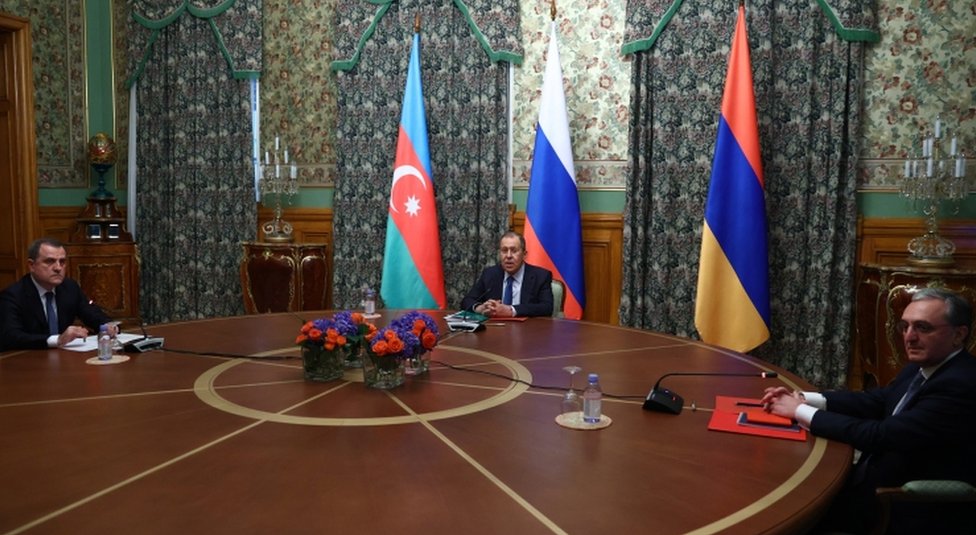 image copyrightEPA
image copyrightEPA
image captionRussia Foreign Minister Sergei Lavrov (c) is hosting his Azerbaijani and Armenian counterparts in Moscow
Armenia and Azerbaijan are holding their first direct talks since clashes over the disputed Nagorno-Karabakh region flared up nearly two weeks ago.
The talks in Moscow between the countries' foreign ministers are being mediated by their Russian counterpart, Sergei Lavrov.
The UN says it is concerned by reports that populated areas are being shelled.
More than 300 people have died and thousands displaced since the latest violence broke out on 27 September.
Nagorno-Karabakh is run by ethnic Armenians although it is officially part of Azerbaijan. The two former Soviet republics have blamed each other for the latest outbreak of violence - the worst in decades.
What's the latest from Moscow?
"It has begun," Russian foreign ministry spokeswoman Maria Zakharova posted on Facebook, along with a photograph of the three ministers sitting around a table.
The talks then continued late into the night, with no word on how they were progressing. It was not clear if the ministers would address reporters afterwards.
Earlier, Azerbaijani President Ilham Aliyev made a televised address saying he was willing to give Armenia "perhaps the last chance" to resolve the conflict peacefully.
"We are on the righteous path. We are winning and we will retake our lands and restore out territorial integrity," he said.
"However, we are still giving the occupier perhaps the last chance - leave our lands," he added.
Turkey, which supports its traditional ally Azerbaijan in the conflict, said on Friday that peace efforts would fail unless Armenia withdrew its forces from the region.
Russia has a military base in Armenia and both are members of the Collective Security Treaty Organization (CSTO) alliance. But Moscow also has good relations with Azerbaijan, and is keen to achieve a peace deal.
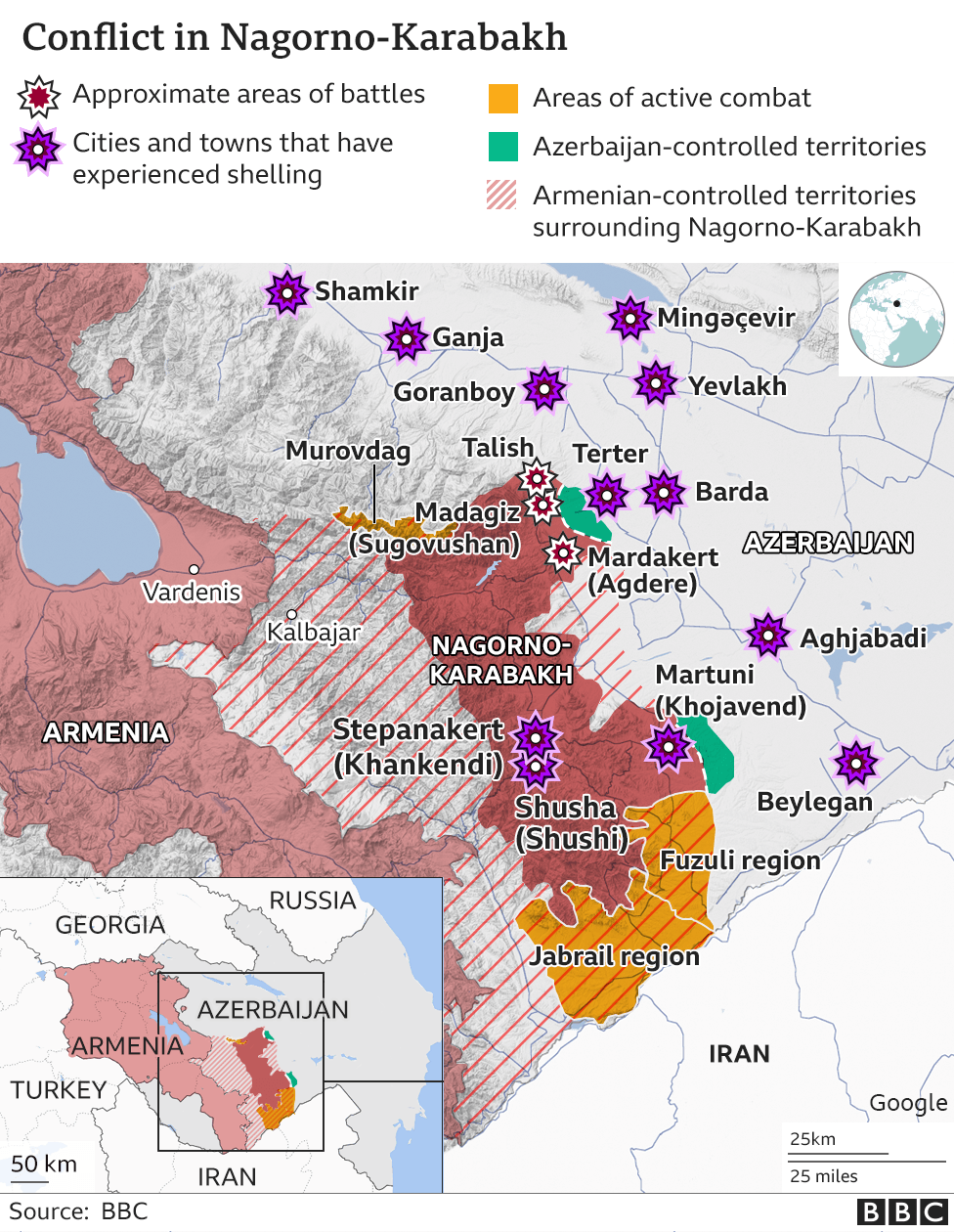

What is the international reaction?
A statement from French President Emmanuel Macron said a breakthrough was possible, but far from certain.
"We are moving towards a truce tonight or tomorrow but it's still fragile," his office told AFP news agency.
France is part of the Minsk Group, along with Russia and the US, which was set up to find a peaceful solution to the Nagorno-Karabakh conflict.
 image copyrightGetty Images
image copyrightGetty Images
image captionThe UN is concerned that shellfire is hitting civilian areas
UN human rights chief Michelle Bachelet called for an "urgent ceasefire due to the impact on civilians".
She said it was "deeply worrying that in recent days we have seen populated areas reportedly targeted and shelled with heavy weaponry in and around the conflict area".
What has been happening on the ground?
The Armenian defence ministry said fighting continued on Friday despite the talks in Moscow.
On Thursday, Armenia had accused Azerbaijan of deliberately shelling a historic cathedral in Nagorno-Karabakh.
Pictures showed serious damage at the Holy Saviour Cathedral in Shusha city (known as Shushi in Armenian).
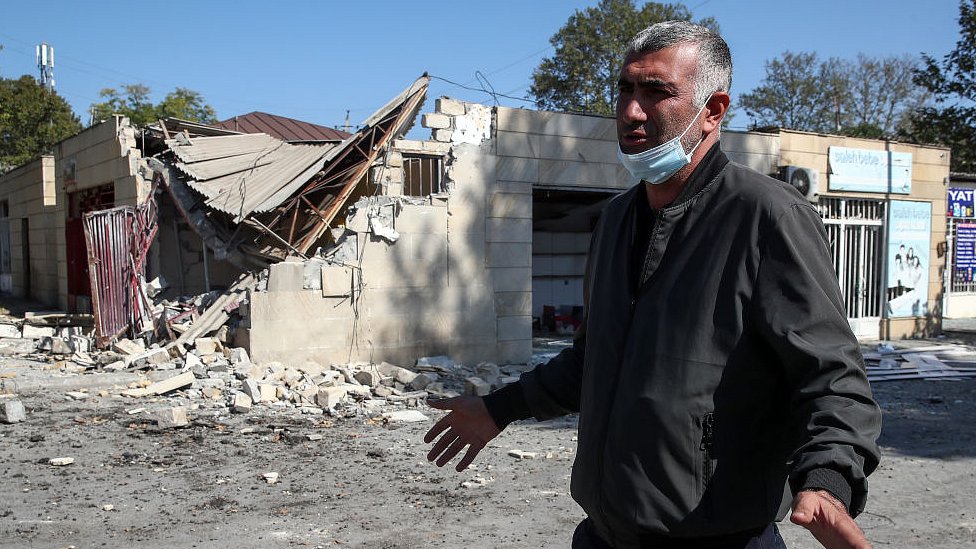 image copyrightGetty Images
image copyrightGetty Images
image captionAzerbaijan said the city of Tartar was among those hit by shellfire
Azerbaijan said on Thursday that its second-largest city, Ganja, and the region of Goranboy had been shelled by Armenian forces, killing at least one civilian.
The clashes have displaced half of Nagorno-Karabakh's population - about 70,000 people - officials said. The region's main city, Stepanakert, has suffered several days of shelling with residents sheltering in basements and much of the city left without power.
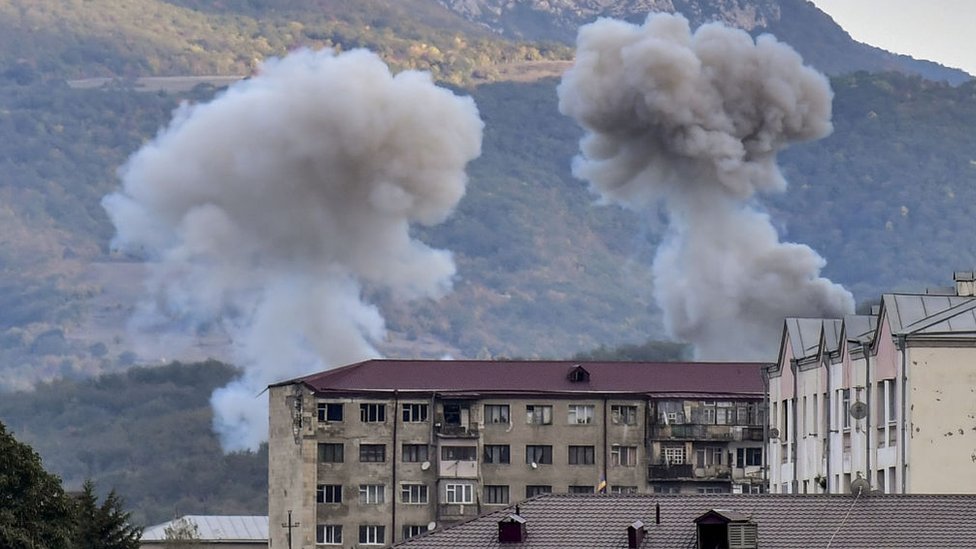 image copyrightGetty Images
image copyrightGetty Images
image captionStepanakert has suffered days of shelling
Armenia and Azerbaijan went to war over Nagorno-Karabakh in 1988-94, eventually declaring a ceasefire. However, they have never reached a settlement over the dispute.

Nagorno-Karabakh - key facts
media captionRos Atkins explains why fighting over the disputed region of Nagorno-Karabakh continues to intensify
Related Topics
posted for fair use
video n photos available at source
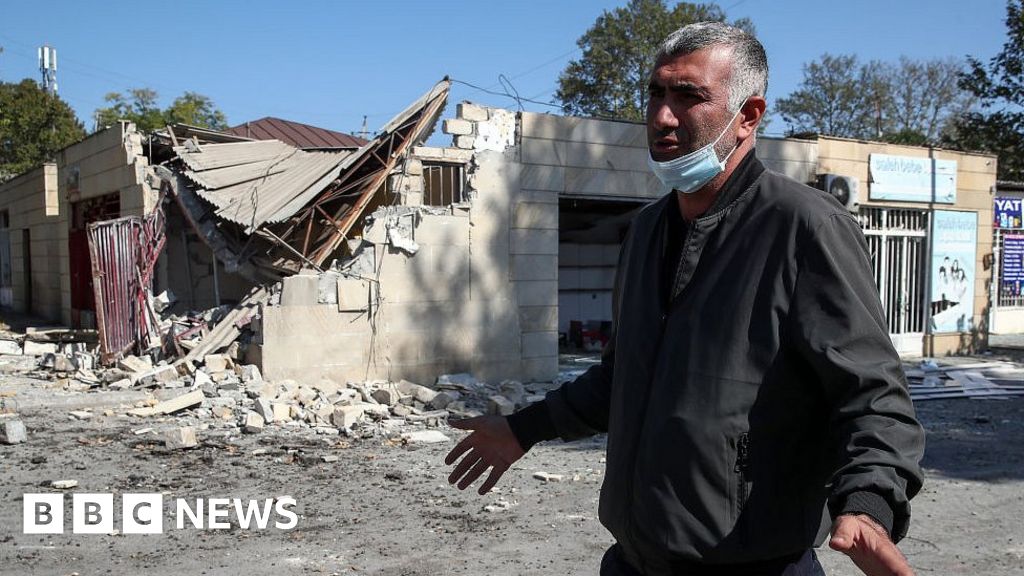
 www.bbc.com
www.bbc.com
Published
6 hours ago
Related Topics

image captionRussia Foreign Minister Sergei Lavrov (c) is hosting his Azerbaijani and Armenian counterparts in Moscow
Armenia and Azerbaijan are holding their first direct talks since clashes over the disputed Nagorno-Karabakh region flared up nearly two weeks ago.
The talks in Moscow between the countries' foreign ministers are being mediated by their Russian counterpart, Sergei Lavrov.
The UN says it is concerned by reports that populated areas are being shelled.
More than 300 people have died and thousands displaced since the latest violence broke out on 27 September.
Nagorno-Karabakh is run by ethnic Armenians although it is officially part of Azerbaijan. The two former Soviet republics have blamed each other for the latest outbreak of violence - the worst in decades.
What's the latest from Moscow?
"It has begun," Russian foreign ministry spokeswoman Maria Zakharova posted on Facebook, along with a photograph of the three ministers sitting around a table.
The talks then continued late into the night, with no word on how they were progressing. It was not clear if the ministers would address reporters afterwards.
Earlier, Azerbaijani President Ilham Aliyev made a televised address saying he was willing to give Armenia "perhaps the last chance" to resolve the conflict peacefully.
"We are on the righteous path. We are winning and we will retake our lands and restore out territorial integrity," he said.
"However, we are still giving the occupier perhaps the last chance - leave our lands," he added.
Turkey, which supports its traditional ally Azerbaijan in the conflict, said on Friday that peace efforts would fail unless Armenia withdrew its forces from the region.
Russia has a military base in Armenia and both are members of the Collective Security Treaty Organization (CSTO) alliance. But Moscow also has good relations with Azerbaijan, and is keen to achieve a peace deal.


What is the international reaction?
A statement from French President Emmanuel Macron said a breakthrough was possible, but far from certain.
"We are moving towards a truce tonight or tomorrow but it's still fragile," his office told AFP news agency.
France is part of the Minsk Group, along with Russia and the US, which was set up to find a peaceful solution to the Nagorno-Karabakh conflict.

image captionThe UN is concerned that shellfire is hitting civilian areas
UN human rights chief Michelle Bachelet called for an "urgent ceasefire due to the impact on civilians".
She said it was "deeply worrying that in recent days we have seen populated areas reportedly targeted and shelled with heavy weaponry in and around the conflict area".
What has been happening on the ground?
The Armenian defence ministry said fighting continued on Friday despite the talks in Moscow.
On Thursday, Armenia had accused Azerbaijan of deliberately shelling a historic cathedral in Nagorno-Karabakh.
Pictures showed serious damage at the Holy Saviour Cathedral in Shusha city (known as Shushi in Armenian).

image captionAzerbaijan said the city of Tartar was among those hit by shellfire
Azerbaijan said on Thursday that its second-largest city, Ganja, and the region of Goranboy had been shelled by Armenian forces, killing at least one civilian.
The clashes have displaced half of Nagorno-Karabakh's population - about 70,000 people - officials said. The region's main city, Stepanakert, has suffered several days of shelling with residents sheltering in basements and much of the city left without power.

image captionStepanakert has suffered days of shelling
Armenia and Azerbaijan went to war over Nagorno-Karabakh in 1988-94, eventually declaring a ceasefire. However, they have never reached a settlement over the dispute.

Nagorno-Karabakh - key facts
- A mountainous region of about 4,400 sq km (1,700 sq miles)
- Traditionally inhabited by Christian Armenians and Muslim Turks
- In Soviet times, it became an autonomous region within the republic of Azerbaijan
- Internationally recognised as part of Azerbaijan, but majority of population is ethnic Armenian
- Self-proclaimed authorities are not recognised by any UN member, including Armenia
- An estimated one million people displaced by war in 1988-94, and about 30,000 killed
- Separatist forces captured some extra territory around the enclave in Azerbaijan
- Stalemate has largely prevailed since a 1994 ceasefire
- Turkey openly supports Azerbaijan
- Russia has a military base in Armenia
media captionRos Atkins explains why fighting over the disputed region of Nagorno-Karabakh continues to intensify
Related Topics
posted for fair use
video n photos available at source

Nagorno-Karabakh: Moscow talks raise hope of ceasefire
Armenia and Azerbaijan hold their first direct talks after two weeks of fighting over the region.
jward
passin' thru
Nagorno-Karabakh conflict: Armenia, Azerbaijan agree ceasefire
The breakthrough came after 10 hours of talks between the two sides in Moscow.
![The breakthrough came after 10 hours of talks in Moscow [Russian Foreign Ministry/Handout via Reuters] The breakthrough came after 10 hours of talks in Moscow [Russian Foreign Ministry/Handout via Reuters]](https://www.aljazeera.com/wp-content/uploads/2020/10/2020-10-09T141828Z_476737555_RC22FJ946YDF_RTRMADP_3_ARMENIA-AZERBAIJAN.jpg?resize=770%2C513)
The breakthrough came after 10 hours of talks in Moscow [Russian Foreign Ministry/Handout via Reuters]
10 Oct 2020
Armenia and Azerbaijan have agreed to a ceasefire from midnight on October 10, and plan to start “substantive” talks over Nagorno-Karabakh, Russian Foreign Minister Sergey Lavrov said on Saturday, after nearly two weeks of fierce fighting in the disputed territory.
The breakthrough came after some 10 hours of talks in Moscow, in the early hours of Saturday morning.
Russia’s top diplomat said the Red Cross would act as an intermediary in the humanitarian operation.
Al Jazeera’s correspondent in Moscow, Alexsandra Stojanovich-Godfroid, said the agreement was for a “humanitarian ceasefire”.
We have to “wait to see whether this ceasefire will really happen as agreed, if it will come down to the exchange of prisoners, and if the parties are really willing to return to the negotiating table to solve this decades long conflict,” she said.
At least 300 people have been reported killed in the fighting, which broke out on September 27 and is the most serious in the territory since clashes in 2016 left dozens dead.
Lavrov did not provide details on the talks but said the Organization for Security and Co-operation in Europe’s (OSCE) Minsk Group would mediate.
Armenian Foreign Minister Zohrab Mnatsakanyan and his Azeri counterpart Jeyhun Bayramov did not speak to reporters.
The renewed fighting in the decades-old conflict has raised fears of a wider war drawing in Turkey, a close ally of Azerbaijan, and Russia, which has a defence pact with Armenia.
Paul Stronski, a senior fellow in the Russia and Eurasia programme at the Carnegie Endowment for International Peace, told Al Jazeera that Nagorno-Karabakh was a “complex issue” for Russia, noting that it was already at loggerheads with Turkey in Syria and Libya. “There’s a real risk this could become a proxy war,” he said.
Under international law, Nagorno-Karabakh is recognised as part of Azerbaijan.
But the ethnic Armenians who make up the vast majority of the population reject Azerbaijani rule, and have been running their own affairs, with Armenia’s support, since a devastating war in the 1990s after the then Soviet Union collapsed.
At least 30,000 people were killed and hundreds of thousands were forced from their homes before an an internationally-brokered ceasefire was agreed in 1994.
Source : Al Jazeera and News agencies
video and photos available at source
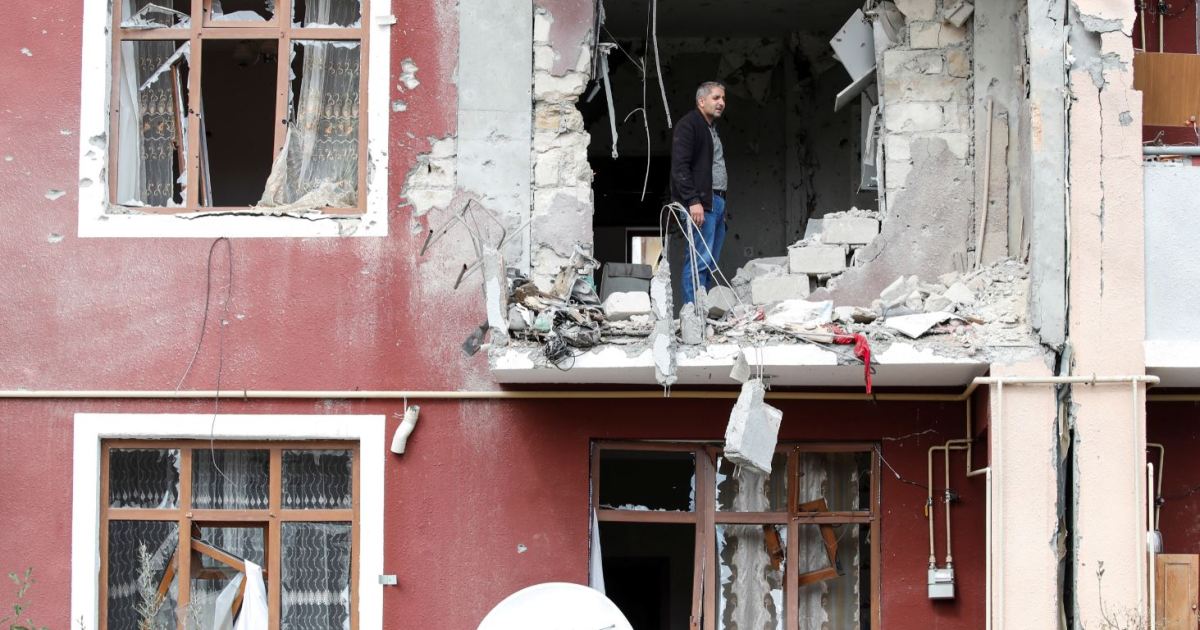
 www.aljazeera.com
www.aljazeera.com
The breakthrough came after 10 hours of talks between the two sides in Moscow.
![The breakthrough came after 10 hours of talks in Moscow [Russian Foreign Ministry/Handout via Reuters] The breakthrough came after 10 hours of talks in Moscow [Russian Foreign Ministry/Handout via Reuters]](https://www.aljazeera.com/wp-content/uploads/2020/10/2020-10-09T141828Z_476737555_RC22FJ946YDF_RTRMADP_3_ARMENIA-AZERBAIJAN.jpg?resize=770%2C513)
The breakthrough came after 10 hours of talks in Moscow [Russian Foreign Ministry/Handout via Reuters]
10 Oct 2020
Armenia and Azerbaijan have agreed to a ceasefire from midnight on October 10, and plan to start “substantive” talks over Nagorno-Karabakh, Russian Foreign Minister Sergey Lavrov said on Saturday, after nearly two weeks of fierce fighting in the disputed territory.
The breakthrough came after some 10 hours of talks in Moscow, in the early hours of Saturday morning.
Russia’s top diplomat said the Red Cross would act as an intermediary in the humanitarian operation.
Al Jazeera’s correspondent in Moscow, Alexsandra Stojanovich-Godfroid, said the agreement was for a “humanitarian ceasefire”.
We have to “wait to see whether this ceasefire will really happen as agreed, if it will come down to the exchange of prisoners, and if the parties are really willing to return to the negotiating table to solve this decades long conflict,” she said.
At least 300 people have been reported killed in the fighting, which broke out on September 27 and is the most serious in the territory since clashes in 2016 left dozens dead.
Lavrov did not provide details on the talks but said the Organization for Security and Co-operation in Europe’s (OSCE) Minsk Group would mediate.
Armenian Foreign Minister Zohrab Mnatsakanyan and his Azeri counterpart Jeyhun Bayramov did not speak to reporters.
The renewed fighting in the decades-old conflict has raised fears of a wider war drawing in Turkey, a close ally of Azerbaijan, and Russia, which has a defence pact with Armenia.
Paul Stronski, a senior fellow in the Russia and Eurasia programme at the Carnegie Endowment for International Peace, told Al Jazeera that Nagorno-Karabakh was a “complex issue” for Russia, noting that it was already at loggerheads with Turkey in Syria and Libya. “There’s a real risk this could become a proxy war,” he said.
Under international law, Nagorno-Karabakh is recognised as part of Azerbaijan.
But the ethnic Armenians who make up the vast majority of the population reject Azerbaijani rule, and have been running their own affairs, with Armenia’s support, since a devastating war in the 1990s after the then Soviet Union collapsed.
At least 30,000 people were killed and hundreds of thousands were forced from their homes before an an internationally-brokered ceasefire was agreed in 1994.
Source : Al Jazeera and News agencies
video and photos available at source

Armenia, Azerbaijan accuse each other of violating ceasefire
Rivals accuse each other of breaking truce in disputed Nagorno-Karabakh within minutes of it coming into effect.
Peapicker
Surrender only to Jesus Christ
IF true, pretty shocking that the Democommies would side with the Christian Armenians
They didn't look that far into the situation. It's only to reject what Trump is doing, doesn't matter which side the administration is supporting.
jward
passin' thru
KTLA
@KTLA
Replying to
@KTLA
The massive group of protesters is making its way to the Turkish consulate. Watch live: https://ktla.com/news/local-new
View: https://twitter.com/KTLA/status/1315440061610160130?s=20
@KTLA
Replying to
@KTLA
The massive group of protesters is making its way to the Turkish consulate. Watch live: https://ktla.com/news/local-new
View: https://twitter.com/KTLA/status/1315440061610160130?s=20

